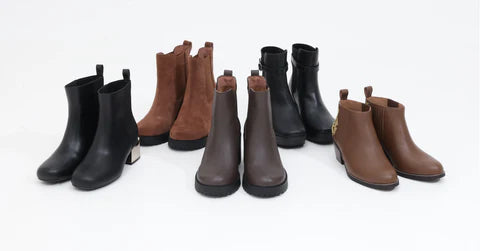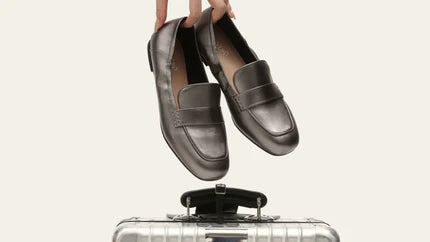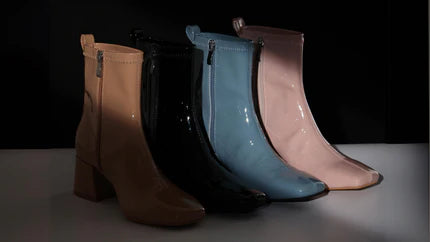Leather shoes tell their story through the wrinkles and creases that develop with time. These aren't just marks; they're proof of genuine leather and show that your shoes are breaking in nicely. This article will walk you through the beauty of these natural signs, how to spot them, and the ways they confirm the quality of your footwear. You'll also learn simple steps to take good care of your leather shoes, keeping them comfortable and stylish for years to come.
What Is Genuine Leather?
Genuine leather is a natural material made from animal hides, most commonly from cows. It's different from artificial or synthetic materials because it comes from a real animal. Here's what makes leather special:
What Makes Leather Unique?
- Leather Can Endure Years of Use: Leather's strength is one of its top features. It's resistant to wear and can endure daily use over many years, maintaining its shape and texture.
- Leather Allows Your Feet to Breathe: Leather has a natural ability to let air pass through, which helps in keeping your feet dry and comfortable.
- Leather Becomes Softer and More Comfortable with Wear: When you first get a leather item, it might feel stiff. However, over time, as you use it, leather becomes more pliable and shapes itself to fit your body perfectly.
- Each Piece of Leather Is Visually Unique: Every piece of leather is distinct, with its grain patterns and textures that give it character.
- Real Leather Has a Unique Smell: Genuine leather carries a specific scent that synthetic materials cannot replicate.
How Is Leather Made?
- The animal's skin is carefully removed to make sure it keeps its high quality.
- Next, the skin is cleaned to get rid of any leftover dirt, blood, and tissue.
- During tanning, the skin is treated with special chemicals that make it tough and prevent it from decaying or getting ruined by water.
- After tanning, the leather is sometimes dyed. This step involves adding color to the leather, which can be as simple as a shade of brown or as bold as bright colors.
- The last step is finishing the leather. In this part of the process, the leather might be oiled, smoothed, shined, pressed with patterns, or given other treatments to create the final look and texture.
This process turns raw animal hide into the soft, strong material used for shoes and other goods. The way leather is made affects how it looks and feels, including how natural creases form over time.
How Do Natural Creases Occur in Leather?
Natural creases are the lines and folds that appear on genuine leather over time. These marks are a normal part of leather's character and show that it's real.

How Do Natural Creases Form?
- Walking and general movement make the leather in shoes bend at certain spots, leading to creases.
- Leather can soak up moisture from the environment or your feet and then dry out, which can change its shape and create crease lines.
- The warmth of your feet softens the leather over time, making it more likely to develop creases where the shoe flexes.
- The more you wear your leather shoes, the more defined and noticeable the crease lines will become.
- Different kinds of leather have different resistance to creasing; softer leathers tend to show creases more quickly than harder ones.
How to Spot Normal Creases in Leather Shoes
- You'll typically find natural creases in places where your foot naturally bends, such as across the toes.
- These creases tend to have a uniform pattern that matches the way your foot moves.
- They're generally shallow and not cut deeply into the leather.
- The color of the leather usually remains consistent, without significant lightening or darkening along the creases.
- Despite the creasing, the leather should retain its smoothness and shouldn't feel rough or show signs of damage.
Signs of wear and tear, on the other hand, might include:
- Cracks in the leather
- Peeling or flaking
- Discoloration
- Rough or damaged areas
Why Are Natural Leather Textures Appealing?
If you see those little lines and wrinkles on your leather boots or loafers, don't worry – they're part of what makes leather shoes special. These creases happen naturally and are just a normal feature of leather that many people actually like because they add character to your shoes.
Shoes Naturally Develop Creases with Wear
Leather shoes show creases from regular use, and this is a natural result of their material. In the fall and winter, you might notice this more because we wear these sturdy shoes often in these seasons with proper socks. The Sam Lucky Penny Leather Loafers from Wydr Studios are made with this kind of high-quality leather. So if you wear them a lot when it's cold out, they're going to get those creases. It's normal and shows that your loafers are made from real leather.
Creases Show the Quality of Leather
Sturdy boots become essential in chilly weather, and genuine leather boots will start to show creases with regular wear. This is how you know they are made from good material. The Rebel Lug Heel Chelsea boots from Wydr Studios will develop these crease marks as well, which is expected since they're made from genuine leather. When you see these marks, you can be sure your boots are strong and authentic, ready for many winters to come.

The Aging Process Improves Leather's Look
When leather gets older, it changes color slightly and becomes shinier. This process is natural and makes the leather look even better. It's something you'll notice especially in the colder months. For example, the Morgan Combat Boots from Wydr Studios will change like this with time and use. As you wear them through various fall and winter days, the surface of the boots will crease and polish, showing their quality.
Creases Indicate a Good Fit
Creases on leather shoes appear after you've worn them for a while. These creases mean the shoes fit your feet well and have become comfortable. The Liza Platform Loafers from Wydr Studios are designed to mold to your feet and will show creases with time. This is a good sign: it means the leather is softening and shaping to your feet, giving you a custom fit during the cooler seasons.
Each Pair of Boots Creases Differently
Different types of boots will show creases in different ways. This is because everyone walks differently, and the leather responds to how it's used. The Jackson Scrunch Loafer from Wydr Studios, with its flexible design and soft leather, will also develop creases from frequent use. These creases indicate the high quality of the leather and that it's becoming shaped to your own way of walking as you wear them through the season.
These natural textures are often seen as a good thing in leather footwear. They show the shoes are real leather and have been used, which many people find more interesting than perfectly smooth, unmarked shoes. This is especially true for casual styles of boots and loafers worn in fall and winter.
How to Distinguish Genuine Leather From Faux Leather by Creases
When trying to figure out if leather is real or not, just take a close look at the wrinkles. Real leather wrinkles slowly and naturally from being handled, while fake leather might have creases that look sharp and feel stiff right away. Here are some key differences to look for:
Real Leather Creases Form Slowly Over Time
Genuine leather creases develop slowly through regular use, while faux leather might show abrupt crease lines. The gradual wear pattern in real leather reflects its flexibility and ability to adapt to the wearer's habits.
Genuine Leather Creases Are Soft and Smooth
Creases in genuine leather retain a certain softness and smoothness, whereas faux leather might feel harder or more plastic-like when it wrinkles. The tactile experience of touching real leather creases can be a telltale sign of quality.
Natural-Looking Creases Indicate Authentic Leather
The random and natural-looking crease patterns found on genuine leather contrast with the often uniform appearance of creases on fake leather, which may look machine-made or unnaturally perfect.
Genuine Leather Remains Durable When Creased
While genuine leather remains strong even where it creases, synthetic leather can weaken, leading to cracks or peeling. The endurance of real leather creases is a testament to its lasting quality.
Real Leather Creases Develop a Beautiful Patina
Over time, creases in real leather deepen and become more pronounced but do so in a way that enhances the leather's feel and appearance. Conversely, faux leather creases may deteriorate quickly, not changing much from the moment they first appear or getting markedly worse.
In high-quality leather goods, natural creases are not seen as flaws. Instead, they're considered part of the leather's character and beauty. These marks show that the item is made from real, high-grade leather that will last a long time and look good as it ages.

How to Care for Leather Shoes with Natural Creases
Taking care of leather shoes with natural creases helps keep them looking good and lasting longer. Here's how to maintain your leather footwear:
Basic Care Tips for Leather Shoes
- Clean shoes with a damp cloth to remove surface dirt.
- Dry wet shoes at room temperature, away from direct heat and sunlight to prevent damage.
- Insert shoe trees after wear to absorb moisture and keep the shape.
- Rotate your shoes to let them breathe and reduce moisture buildup.
- Use a soft brush for a quick polish and to keep the leather shiny.
- Storage them in proper way.
Select Appropriate Products for Leather Care
Keep your leather supple and crack-free with occasional conditioning. Brighten up the color and get a subtle glow with a cream polish that matches your shoes. Waterproof sprays are great for those rainy days but remember—a little goes a long way. For a deep clean, a dedicated leather cleaner is best. To maintain a consistent shine without altering the color, opt for a neutral polish as a finishing touch in your care routine.
Proper Application of Leather Care Essentials
Before you add any products, ensure your shoes are spotless. Gently work a dab of conditioner into the leather using a soft cloth and circular strokes for an even coat. Polish lightly to keep the gleam and color protection on point. If rain is on the horizon, a restrained spray of waterproofing can save the day. Taking these steps will not only keep your shoes looking fabulous but also help preserve their natural allure over many wears.
A little product goes a long way. Too much can clog the leather's pores. The goal is to care for the leather while letting its natural beauty, including creases, shine through.

The Bottom Line
Natural creases in leather shoes are special marks that show the leather is real and of good quality. They tell the story of how you've worn your shoes. When you take care of your leather shoes, you're keeping something well-made in good shape. Next time you buy leather shoes, look for these natural marks. They're a good sign. As you wear your shoes, enjoy how they change and become more your own over time. Just like favorite old things get better with age, good leather shoes become more special the more you wear them.



